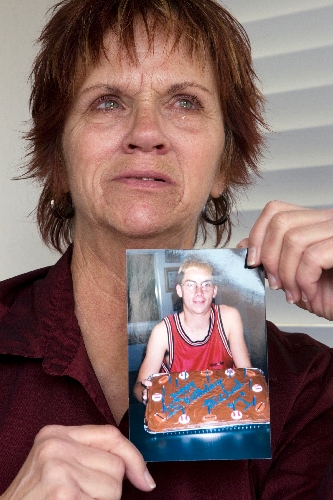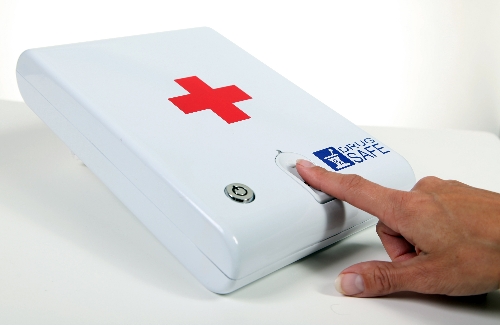Officials offer advice on proper use, disposal, storage of medications




The paramedics who rushed the woman to University Medical Center after a friend found her on the floor believed she may have suffered a reaction to medications she had taken.
So they brought with them in the ambulance a large bag that contained all the prescription and over-the-counter medications that were in her medicine cabinets — dozens of bottles, most of them old prescriptions with warnings that the pills should not be taken after a specific date.
Fortunately, the woman regained consciousness as Dr. Dale Carrison, head of UMC’s adult emergency department, and a medical team cared for her.
“It turned out she was confused about what she was supposed to take,” Carrison said recently. “She was taking prescription medicines together that didn’t make any sense, that were dangerous together.
“People have to clean out their medicine cabinets.”
Carrison’s “clean out” message is echoed by law enforcement officials, who are alarmed at not only accidental but also intentional abuse of prescription drugs.
Michele Leonhart, head of the federal Drug Enforcement Administration, refers to abuse of prescription drugs as an “epidemic.” According to the Centers for Disease and Prevention, prescription drugs are now responsible for more overdose deaths across the nation than “street drugs” such as cocaine, heroin and amphetamines. That holds true in Clark County.
In 2009, the last year in which Clark County Coroner Mike Murphy said he has complete statistics, 304 people died of overdoses of prescription narcotics, compared with 108 deaths from street drugs.
“Not only should people clean out their medicine cabinets,” said Las Vegas police narcotics detective Bruce Gentner, “they should also keep what they have left secured so others can’t get at it. It may take a safe. But it has to be done. We have kids getting together for what are known as ‘pharm’ parties, where everyone brings prescription drugs they’ve gotten from home. Then they put them in a bowl and see how they get ‘high.’ It’s very dangerous. They don’t know what they’re taking.”
Statistics released by the DEA support Gentner’s contention. The agency says that each day 2,500 teens abuse prescription drugs for the first time. The number of emergency room visits attributable to pharmaceuticals alone is up 97 percent nationally between 2004 and 2008.
Steve Pasierb, president of the New York City-based Partnership for a Drug Free America, told the Review-Journal that there is no doubt where the abused drugs are coming from.
“Our research has found that the No. 1 source of medicine that kids abuse is the medicine cabinet at home or from a family member’s home or friend’s cabinet,” Pasierb said.
Gentner said in the near future the police department will formally announce that Metro substations will have secure disposal points for people to drop off unused prescription medications.
Last year, police gave Las Vegas Valley residents four chances to dispose of prescription medications. People dropped off more than 2,000 pounds of unused prescription drugs, and many residents wondered why there wasn’t a permanent place to dispose of expired and unused medication. They said they had held onto them because of the difficulty in disposing of them.
Authorities have long warned about flushing drugs down the toilet because they could enter the water supply. They also cautioned against throwing them in the trash because children and animals could get into possible lethal medicines. And it was against the law for pharmacies to take back the property of a patient.
People across the nation have complained that various recommendations for disposing of unused drugs was unwieldy.
For solid pills, authorities have suggested crushing them into powder, adding water and kitty litter or sawdust, and then placing them into a sealed bag for disposal in the trash. Liquid medications should be poured into a plastic bag with sawdust to soak up the liquid. Old prescription bottles should have the patient’s identity removed from the label.
A new law called the Safe Drug Disposal Act that was signed by President Barack Obama in October makes it possible for communities to now undertake the kind of disposal effort that Gentner said Las Vegas police will lead.
Paul Oesterman, a professor of pharmacy at the University of Southern Nevada who has worked closely with authorities on the area’s “Operation Medicine Cabinet” campaigns to take back drugs, lauds Las Vegas police for coming up with the prescription drug disposal points.
“We have a real problem with the abuse of prescription medication in this country and in Las Vegas,” he said. “And this will make it so much easier for people to take control in their own homes. Every six months people should clean out their medicine cabinets. This unused medication will be incinerated and be done in such a way that it generates power. It’s a win-win for people.”
About 145 University of Southern Nevada students got involved in the four Operation Medicine Cabinet campaigns, helping authorities work with residents at disposal sites. The last “take back” in September was a nationwide event sponsored by the DEA. David Ausiello, a DEA spokesman, said authorities took back 121 tons of unused prescription drugs, about the weight of a full-grown blue whale or 25 African elephants.
“One of our students knew someone at Green Valley High School who overdosed and wanted to do something to end this problem,” said Oesterman , who noted that university students talk to area high school students about the dangers of prescription medications.
So does Mary Ribaudo , whose son Michael became addicted to pain relievers, overdosed and died at age 23. Now, she wages a campaign to highlight the dangers of prescription drugs to young people as a volunteer for the Narcotic Educational Foundation of Nevada.
“His drug problems began with prescription painkillers. And now I make it my mission to tell people how dangerous they are,” Ribaudo said. “We’ve become lazy and want a pill when we should just deal with things. The risks of addiction are great.
“We’ve got to keep kids from getting in their parents’ medicine cabinets.”
Federal studies have shown that two in five teens believe that prescription drugs are “much safer” than illegal drugs. And three in 10 teens believe that prescription pain relievers are not addictive.
“It’s unfortunate that they think that because the drugs come from a doctor they’re not dangerous,” said pharmacist Oesterman. “Nothing could be further from the truth.”
Coroner Murphy said he often learns when drug overdose deaths are investigated that individuals have thought that “if one pill is good, then two or three must be better.”
“That’s why they end up with me,” he said.
People need to understand, he said, that just because a drug has been prescribed as safe to one person doesn’t mean it will be OK for someone else. A medical history should be taken so there isn’t a dangerous reaction, he said.
Even when an individual is under a doctor’s care, potent prescription drugs can be dangerous.
Because of the danger of prescription drugs getting into the wrong hands, many health professionals and lawmen believe the time has come for parents to keep drugs locked up.
Oesterman said parents who feel that keeping drugs locked up reflects badly on their children aren’t living in the real world.
“They’ve got blinders on,” he said. “We’re a different society today.”
A Henderson company began producing a safe for prescription drugs, called the RxDrugSAFE, last year. Engineered with heavy gauge steel, it has been designed with fingerprint technology that allows the owner to open it only after being recognized by the safe.
Lorraine Yarde, a spokeswoman for the company , said that while the safe retails at $199, it is often sold by the company for $100 less as part of safety campaigns.
Dr. Jay Fisher, head of UMC’s pediatric department, is mindful about all the talk about teens purposely taking drugs, but he doesn’t want people to forget how important it is to also to be vigilant about keeping prescription drugs out of the hands of small children.
The federal Centers for Disease Control and Prevention reports that two out of every three pediatric poisonings that result in an emergency room visit are caused by medication overdoses. No longer are household cleaners and pesticides the most dangerous poisoning threat to small children at home.
Fisher said he sees about one case a week where a child ingested a medication because a parent or parents were distracted by other family business.
“You have to be so disciplined in watching your children, but that’s what parents must be,” he said. “I’ve seen cases where the mother had a pill laid out for breakfast and the phone rings. And then the 2-year-old does what mommy does and takes it. Fortunately, we don’t see many fatals. But you never know.”
Contact reporter Paul Harasim at
pharasim@reviewjournal.com or 702-387-2908.
People across the nation have complained that various recommendations for disposing of unused drugs was unwieldy.
For solid pills, authorities have suggested crushing them into powder, adding water and kitty litter or sawdust, and then placing them into a sealed bag for disposal in the trash.
Liquid medications should be poured into a plastic bag with sawdust to soak up the liquid.
Old prescription bottles should have the patient’s identity removed from the label.












